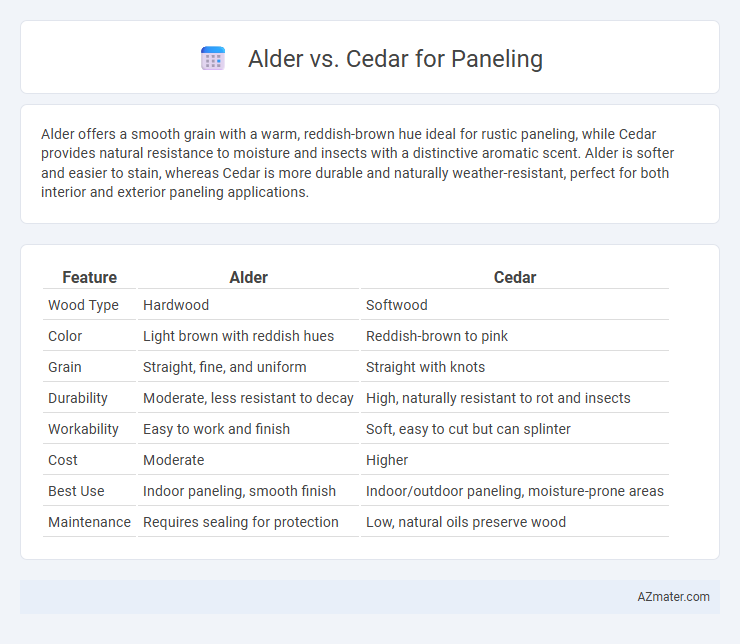Alder offers a smooth grain with a warm, reddish-brown hue ideal for rustic paneling, while Cedar provides natural resistance to moisture and insects with a distinctive aromatic scent. Alder is softer and easier to stain, whereas Cedar is more durable and naturally weather-resistant, perfect for both interior and exterior paneling applications.
Table of Comparison
| Feature | Alder | Cedar |
|---|---|---|
| Wood Type | Hardwood | Softwood |
| Color | Light brown with reddish hues | Reddish-brown to pink |
| Grain | Straight, fine, and uniform | Straight with knots |
| Durability | Moderate, less resistant to decay | High, naturally resistant to rot and insects |
| Workability | Easy to work and finish | Soft, easy to cut but can splinter |
| Cost | Moderate | Higher |
| Best Use | Indoor paneling, smooth finish | Indoor/outdoor paneling, moisture-prone areas |
| Maintenance | Requires sealing for protection | Low, natural oils preserve wood |
Introduction to Wood Paneling Choices
Alder and cedar are popular wood choices for paneling, each offering distinct aesthetic and practical benefits. Alder features a smooth grain with warm, reddish-brown tones that enhance interior warmth, while cedar provides natural resistance to moisture and insects, making it ideal for humid environments. Choosing between alder and cedar depends on desired visual appeal, durability needs, and maintenance preferences for wood paneling projects.
Overview of Alder and Cedar
Alder paneling offers a smooth, fine-grained texture with a warm, reddish-brown hue that darkens over time, making it ideal for creating a cozy, rustic ambiance. Cedar is renowned for its natural resistance to moisture, decay, and insects, featuring a distinct aromatic quality and a rich, reddish tone that ranges from light amber to deep chestnut. Both woods are popular for paneling due to their durability and aesthetic appeal, with alder providing a softer wood for easy customization and cedar valued for its longevity and natural protective properties.
Appearance and Aesthetic Differences
Alder wood showcases a warm, reddish-brown tone with a subtle grain pattern, creating a smooth and uniform appearance ideal for rustic or traditional paneling. Cedar, in contrast, features rich, reddish hues with pronounced knots and a more textured grain, lending a natural, aromatic character to spaces and enhancing cabin or lodge-style aesthetics. The choice between Alder and Cedar for paneling largely depends on desired warmth and texture, with Alder offering a more consistent finish and Cedar providing distinct visual interest through its grain and color variations.
Durability and Strength Comparison
Alder offers moderate durability and strength, making it suitable for interior paneling where aesthetics are prioritized over heavy wear. Cedar boasts superior resistance to moisture, decay, and insect damage, providing enhanced longevity and structural integrity in paneling applications. For environments exposed to humidity or frequent use, cedar is the preferred choice due to its natural durability and robust strength.
Resistance to Moisture and Decay
Cedar is known for its superior resistance to moisture and decay compared to Alder, making it a preferred choice for paneling in high-humidity or exterior environments. Cedar contains natural oils and compounds that inhibit fungal growth and rot, enhancing its durability in damp conditions. In contrast, Alder is more susceptible to moisture damage and requires proper sealing to maintain its appearance and structural integrity over time.
Workability and Installation
Alder wood offers superior workability for paneling due to its softer texture, allowing for easier cutting, sanding, and shaping compared to cedar. Cedar, while slightly softer than many hardwoods, has natural oils that can resist moisture and decay but may cause minor issues with fastening due to its resin content. Installation of alder panels is typically smoother with fewer splinters and easier nail or screw penetration, whereas cedar panels require careful handling to prevent surface blemishes and ensure long-term durability in humid environments.
Cost and Availability
Alder paneling generally costs less than cedar, making it a budget-friendly option for interior spaces. Alder wood is widely available due to its fast growth rate, ensuring steady supply and affordable pricing. Cedar, while more expensive, is prized for its natural resistance to decay and insects, though its availability can vary regionally, impacting overall cost.
Environmental Impact and Sustainability
Alder wood paneling, sourced from faster-growing trees, offers a more sustainable option compared to cedar, which grows slower and can lead to deforestation if not responsibly harvested. Cedar naturally resists decay and insects, reducing the need for chemical treatments that can harm ecosystems. Selecting FSC-certified alder or cedar ensures environmentally responsible forestry practices, aiding in forest preservation and reducing carbon footprints.
Best Applications for Alder vs Cedar
Alder wood excels in indoor paneling applications due to its smooth grain, warm reddish-brown tones, and excellent stain absorption, making it ideal for cozy living rooms, cabinets, and furniture facing. Cedar paneling offers superior resistance to moisture, decay, and insects, perfect for outdoor structures, saunas, and bathrooms where durability and natural aromatic properties are essential. Choosing Alder enhances aesthetic appeal in controlled environments, while Cedar provides robust protection and longevity in humid or exterior conditions.
Conclusion: Which Wood Is Right for Your Project?
Alder wood offers a warm, uniform grain perfect for staining, making it ideal for projects requiring a smooth, consistent finish. Cedar provides natural resistance to moisture and insects, with a distinctive aroma and rich color variations suited for rustic or exterior applications. Choosing between alder and cedar depends on your project's aesthetic goals, durability needs, and exposure to environmental factors.

Infographic: Alder vs Cedar for Paneling
 azmater.com
azmater.com